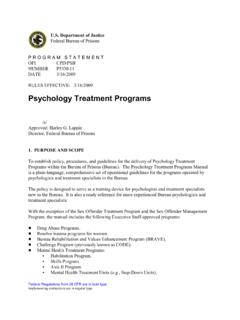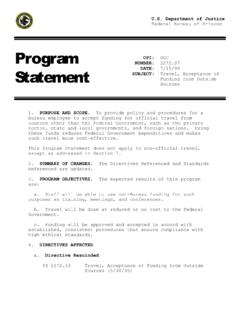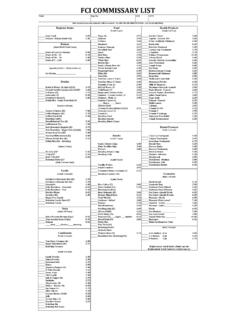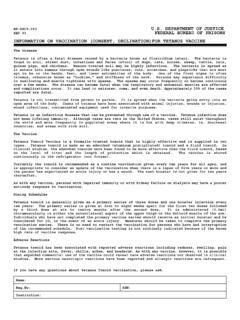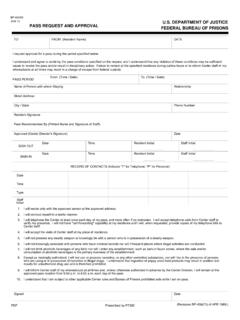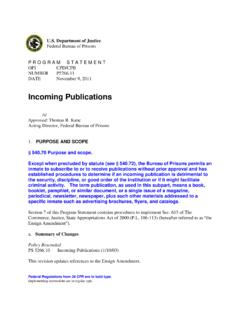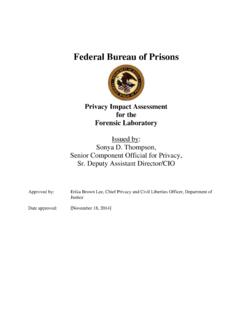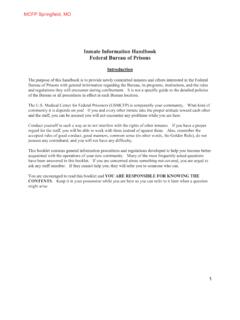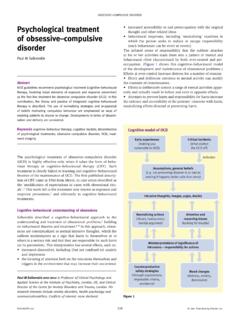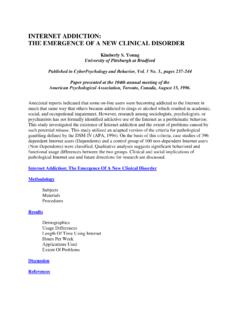Transcription of Treatment and Care of Inmates With Mental Illness
1 Department of Justice Federal Bureau of Prisons P R O G R A M S T A T E M E N T OPI: RSD/PSB NUMBER: DATE: May 1, 2014 Treatment and Care of Inmates With Mental Illness /s/ Approved: Charles E. Samuels, Jr. Director, Federal Bureau of Prisons 1. PURPOSE AND SCOPE This Program Statement provides policy, procedures, standards, and guidelines for the delivery of Mental health services to Inmates with Mental Illness in all Federal Bureau of Prisons (Bureau) correctional facilities. For the purpose of this Program Statement, Mental Illness is defined as in the most current Diagnostic and Statistical Manual of Mental Disorders: A Mental disorder is a syndrome characterized by clinical significant disturbance in an individual s cognition, emotion regulation, or behavior that reflects a dysfunction in the psychological, biological, or developmental processes underlying Mental functioning.
2 Mental disorders are usually associated with significant distress or disability in social, occupational, or other important activities. Classification of an inmate as seriously mentally ill requires consideration of his/her diagnoses; the severity and duration of his/her symptoms; the degree of functional impairment associated with the Illness ; and his/her Treatment history and current Treatment needs. Mental illnesses not listed below may be classified as seriously mentally ill on a case-by-case basis if they result in significant functional impairment. The following diagnoses are generally classified as serious Mental illnesses: Schizophrenia Spectrum and Other Psychotic Disorders.
3 5/1/2014 2 Bipolar and Related Disorders. Major Depressive Disorder. In addition, the following diagnoses are often classified as serious Mental illnesses, especially if the condition is sufficiently severe, persistent, and disabling: Anxiety Disorders. obsessive - compulsive and Related Disorders. Trauma and Stressor-Related Disorders. Intellectual Disabilities and Autism Spectrum Disorders. Major Neurocognitive Disorders. Personality Disorders. The primary purpose of this Program Statement is to ensure that Inmates with Mental Illness are identified and receive Treatment to assist their progress toward recovery, while reducing or eliminating the frequency and severity of symptoms and associated negative outcomes of Mental Illness , such as exacerbation of acute symptoms, placement in restrictive housing, need for psychiatric hospitalization, suicide attempts, and death by suicide.
4 The secondary purpose of this Program Statement is to address dynamic risk factors associated with recidivism in Inmates with Mental Illness to increase pro-social and adaptive living skills and the likelihood of successful reentry to the community. a. Summary of Changes Policy Rescinded Institution Management of Mentally Ill Inmates (3/31/95) This reissuance incorporates the following modifications: Evidence-Based Practices for the Treatment and care of mentally ill Inmates are detailed and Priority Practices are established. The Mental health care level system is operationalized. Mental health care level definitions are provided, which include diagnostic, impairment, and intervention-based criteria.
5 In addition, care level-based Treatment and documentation requirements are noted. A team approach to Mental health care is established, including introduction of an institution Care Coordination and Reentry (CCARE) Team with joint Psychology Services and Health Services membership. Enhanced procedures for screening, evaluation, and intervention with Inmates in restrictive housing settings are detailed. 5/1/2014 3 Procedures for providing Mental health training for staff are outlined, including basic training for all staff as well as specialty training for interested staff. A Mental health companion program is established to provide peer assistance and support to Inmates with Mental illnesses.
6 Achievement awards for inmate participation in Mental health programming are introduced. Designation, transfer, and release procedures for mentally ill Inmates are updated and refined, with an emphasis on continuity of care both across institutions and to the community. b. Program Objectives To identify Inmates with Mental Illness through screening and classification upon their entry into the Bureau and again upon their arrival at an institution to achieve an accurate diagnosis and determine the severity of Mental Illness and suicide risk. To ensure Psychology Treatment Programs and Mental health interventions prescribed in Treatment plans ordinarily rely on evidence-based practices for the Treatment of Inmates with Mental Illness and rehabilitation needs.
7 To extend support for Inmates with Mental Illness beyond traditional professional services through creation of specific supportive communities, specialized staff training, inmate peer support programs, care coordination teams, and institutions with specialized Mental health missions. To enhance continuity of care through a network of accessible, interrelated interventions and communication among care providers when Inmates transfer between institutions, to a Residential Reentry Center (RRC), to home confinement, or to the community. To reduce the proportion of Inmates with Mental Illness in restrictive housing settings through informed disciplinary processes, initial screening procedures, enhanced Treatment in these settings, and strategies for successful reintegration into the general population.
8 To increase rates of successful reentry among Inmates with Mental Illness through accurate identification of at-risk Inmates , effective skill building in prison, and comprehensive release plans. 2. RESPONSIBILITIES a. Psychology Services Branch and Health Services Division. The Psychology Services Branch (Branch), Reentry Services Division, and Health Services Division (HSD) provide oversight and consultation regarding institution Treatment and care of Inmates with Mental Illness through remote reviews of the Psychology Data System (PDS) in the Bureau Electronic Medical Record (BEMR) and other BEMR documentation; remote reviews of Inmates in restrictive housing; recommendations regarding transfers and designations of mentally ill Inmates ; and 5/1/2014 4 direct consultation with Chief Psychologists, Psychiatrists, other Health Services staff, and Executive Staff.
9 The Branch is responsible for developing Annual Refresher Training lesson plans that provide staff with information about working with mentally ill Inmates . They also develop and disseminate supplemental staff training materials for use by the Mental Health Treatment Coordinator during staff recalls, lunch and learn events, department head meetings, etc. The Branch also identifies and disseminates evidence-based practices, described below. b. Warden. Each Warden is responsible for the appropriate management of mentally ill Inmates in his/her institution. He/she must provide the Mental Health Treatment Coordinator with adequate time to educate staff about the need to detect and report any unusual inmate behaviors that might suggest Mental Illness .
10 For example, this education should occur at department head meetings, staff recalls, lieutenants meetings, and annual training. c. Chief Psychologist. Each Chief Psychologist ensures the provisions of this Program Statement are implemented, including designation of a psychologist to serve as Mental Health Treatment Coordinator, and informing institution staff of the designation. The Chief Psychologist is also responsible for ensuring information about the availability of Mental health services is disseminated to Inmates during Admission and Orientation. Specifically, the Chief Psychologist ensures the Admission and Orientation lesson plan developed by the Psychology Services Branch is utilized to convey this information.

